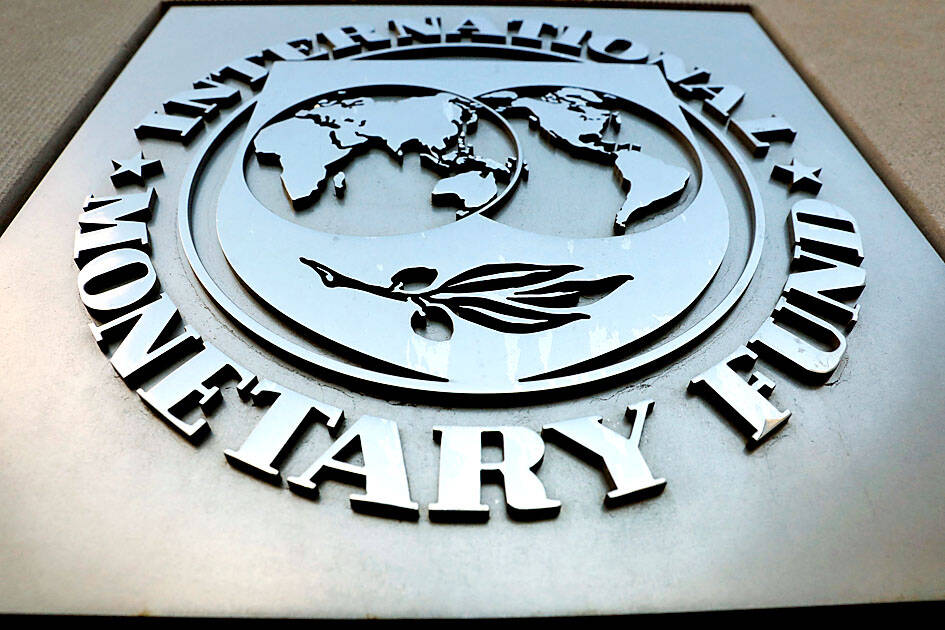Global public debt is expected to reach a record US$100 trillion this year, the IMF said yesterday, warning that the fiscal outlook for many countries might be even “worse than expected.”
In its latest report on fiscal policy, the IMF said it expects global public debt to hit 93 percent of global GDP this year, and to approach 100 percent of GDP by 2030 — 10 percentage points higher than in 2019, before the COVID-19 pandemic.
“Global public debt is very high,” IMF Fiscal Affairs Department deputy director Era Dabla-Norris told reporters ahead of the report’s publication.

Photo: Reuters
“There are very good reasons to believe that the debt burden — or the debt outlook — could be worse than expected,” Dabla-Norris said, pointing to spending pressures to address issues such as climate change, overly optimistic debt projections and the possibility of large amounts of unidentified debt.
“So the bottom line is that it’s time for countries to get their fiscal house in order,” she said.
The IMF report introduced a new “debt at risk” approach to assessing the risks to debt projections.
It estimated that, in a worst-case scenario, global public debt could hit 115 percent of GDP by 2026 — almost 20 percentage points higher than the IMF’s baseline estimate.
The report found that “global factors increasingly drive the fluctuations in government borrowing costs across countries,” suggesting that elevated levels of debt in key countries could “increase the volatility of sovereign yields and debt risks” for others.
Moderating inflation and interest rate cuts in many economies meant now was an “opportune” time for countries to rebuild their fiscal buffers, the IMF said, adding that they were “better placed” than before to absorb the effect of fiscal tightening.
The size of the fiscal adjustment needed to bring global public debt back under control was between 3.0 and 4.5 percent of GDP, on average, it said — almost twice the size of past adjustments.

Anna Bhobho, a 31-year-old housewife from rural Zimbabwe, was once a silent observer in her home, excluded from financial and family decisionmaking in the deeply patriarchal society. Today, she is a driver of change in her village, thanks to an electric tricycle she owns. In many parts of rural sub-Saharan Africa, women have long been excluded from mainstream economic activities such as operating public transportation. However, three-wheelers powered by green energy are reversing that trend, offering financial opportunities and a newfound sense of importance. “My husband now looks up to me to take care of a large chunk of expenses,

SECTOR LEADER: TSMC can increase capacity by as much as 20 percent or more in the advanced node part of the foundry market by 2030, an analyst said Taiwan Semiconductor Manufacturing Co (TSMC, 台積電) is expected to lead its peers in the advanced 2-nanometer process technology, despite competition from Samsung Electronics Co and Intel Corp, TrendForce Corp analyst Joanne Chiao (喬安) said. TSMC’s sophisticated products and its large production scale are expected to allow the company to continue dominating the global 2-nanometer process market this year, Chiao said. The world’s largest contract chipmaker is scheduled to begin mass production of chips made on the 2-nanometer process in its Hsinchu fab in the second half of this year. It would also hold a ceremony on Monday next week to

State-run CPC Corp, Taiwan (CPC, 台灣中油) yesterday signed a letter of intent with Alaska Gasline Development Corp (AGDC), expressing an interest to buy liquefied natural gas (LNG) and invest in the latter’s Alaska LNG project, the Ministry of Economic Affairs said in a statement. Under the agreement, CPC is to participate in the project’s upstream gas investment to secure stable energy resources for Taiwan, the ministry said. The Alaska LNG project is jointly promoted by AGDC and major developer Glenfarne Group LLC, as Alaska plans to export up to 20 million tonnes of LNG annually from 2031. It involves constructing an 1,290km

TECH CLUSTER: The US company’s new office is in the Shalun Smart Green Energy Science City, a new AI industry base and cybersecurity hub in southern Taiwan US chip designer Advanced Micro Devices Inc (AMD) yesterday launched an office in Tainan’s Gueiren District (歸仁), marking a significant milestone in the development of southern Taiwan’s artificial intelligence (AI) industry, the Tainan City Government said in a statement. AMD Taiwan general manager Vincent Chern (陳民皓) presided over the opening ceremony for the company’s new office at the Shalun Smart Green Energy Science City (沙崙智慧綠能科學城), a new AI industry base and cybersecurity hub in southern Taiwan. Facilities in the new office include an information processing center, and a research and development (R&D) center, the Tainan Economic Development Bureau said. The Ministry